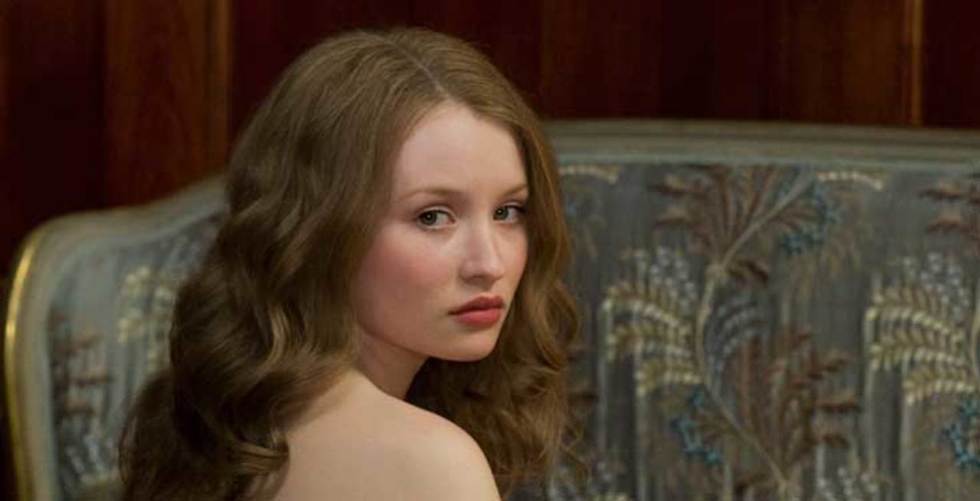
BY ZACHARY WIGON |
Sleeping Beauty: Mystery, Atmosphere, Dream
First-time director Julia Leigh goes heavy on tonal filmmaking with her take on the ethereal, eternal fairy tale.


One of the things that cinema can do better than other art forms is concoct a sense of “atmosphere” – a sensation of inhabiting a thematic or stylistic space while viewing the work that informs what is happening in the story, but is separate from it. Plays and novels can construct atmosphere too, but with all of the formal mechanisms at a filmmaker’s disposal, cinema is inherently better suited to create it; in the process, films can engineer a distance between themselves and the viewer that is extremely difficult, if not impossible, to achieve in other mediums.
Julia Leigh is a first-time filmmaker, an Australian novelist who has made her first movie with Sleeping Beauty, which debuted at Cannes this year; she clearly has a convert’s appreciation for what cinema is inherently suited for. Her film is a story told through a gauzy, dreamy veil, an almost – shall I say – fairy-tale recounting of one young woman’s experience in taking a bizarre job. The young woman is played by the excellent Emily Browning, and the job is to be a “sleeping beauty” – she is paid to be heavily drugged so that men can spend the evening with her as she sleeps. They can do anything to her, so long as there is no actual sexual intercourse. The film deals with power dynamics between the sexes, the mystifying nature of submission and rejection, and the difficulty of emotional intimacy, and clearly emerges as one of the strongest films of the year. I had the pleasure of speaking with Leigh in New York recently.

Tribeca: The film’s narrative is very strange and bizarre, or it seems to be, at first; but as one watches the film, it actually begins to seem quite bizarrely plausible. Could you tell me a bit about the process of taking this unusual narrative device and treating it in a realistic manner?
Julia Leigh: Well, I had read the fairy tale as a girl – the Disney version and the more brutal one. I read and loved two novellas – one of them by Gabriel Garcia Marquez – about older men who pay to spend the night alongside drugged young girls. In the Bible, King David sends out to spend the night with sleeping virgins. There are sleeping girls on the Internet. So I was aware of this ancient concept of sleeping beauties. I responded to that and transformed it.
On a more personal note, after I had my first novel published, I had this recurring nightmare where I dreamed I was being filmed in my sleep – it’s weird because you dream you’re asleep in your own bed, when in fact you are asleep in your own bed. We’re very vulnerable when we sleep. It’s almost as if when we wake up we edit out our nights and stitch together our waking days to form a narrative of the self. So I wondered what it might be like if you knew something was happening to you in your sleep, and you knew it wasn’t very good for you – what might that be like, how might that find its way into your waking life?
But also, when you call something Sleeping Beauty, you’re signaling that it’s not a kitchen-sink drama. I guess with this film I was never interested in a strict naturalism. I was hoping for something heightened, or strange. I’m pleased if you respond to the tone. In literature and film, one of the most important things is also the most ephemeral – tone, or atmosphere. How you create that is a matter of thousands of small decisions.
Tribeca: It’s interesting for you to say that, coming from literature. Coming to cinema, you obviously made a concerted decision to work in film – what do you think film is inherently good at, as a medium?
Julia Leigh: Well, I never asked myself if it should be a book or a film. It came to me in a cinematic form. When I wrote the script, I saw it in my mind’s eye. One thing about this film is that the camera is a kind of tender, steady witness in these long takes. In the first draft of the script, the camera began on that fourth wall of the chamber. Things like that were in the first draft. In a way, I hope with this film that the audience is really aware that they’re watching a film. That they almost become self-conscious about the act of watching. The time they have to look at the scenes is important. I think that is particular to cinema – the act of watching.
Tribeca: So it’s a reflexive exercise, to some degree.
Julia Leigh: You could say that.

Tribeca: The look is beautiful – it’s a very creamy-textured look, very dreamlike. How did you decide to go for that look?
Julia Leigh: The look of the film is so important; so many decisions go into that. I build the color palette with the production designer – that’s a lot of work. There’s a scene in a railway station, and we had to see so many railway stations to find one that would fit our palette, because we didn’t want to have these jarring colors. You also work closely with your DP. One thing that we didn’t really want was high contrast – deep shadow, bright light. We were working with a more gentle light, was how we talked about it. We shot on 35, and then we did a digital intermediate, and we did quite a big grade on it.
Tribeca: It produces this ethereal quality, like a layer of gauze between the film and the viewer.
Julia Leigh: Hopefully it’s quite beautiful, as well.
Tribeca: It’s dreamy – which I guess is appropriate.
Julia Leigh: Yeah.
Tribeca: So many of the scenes are unbroken takes, one wide shot – was that your stylistic conception of the film from the start?
Julia Leigh: Yeah. I always knew I wanted longer takes, as I wrote the script. Some people say the camera’s static, but I would like to remind you that it’s not.
Tribeca: Well, there are a lot of static takes in the film.
Julia Leigh: [Laughs] Well, there’s a few, but not many completely, not completely static. There are small, slow, steady movements. A lot of shots hold for a while, but do move in at some point.
Tribeca: It’s interesting, the way you combine this refined, aristocratic milieu with an illicit, sort of depraved service. Could you speak a bit about the idea of combining those two realms?
Julia Leigh: Oh, it didn’t seem a huge leap to me, to combine them. [Laughs] I don’t know, that just was what I imagined.

Tribeca: I suppose it’s just the idea of what occurs behind closed doors.
Julia Leigh: Yeah. I mean, in the film we get the portrait of Lucy’s reckless youth, and I’d like to think that the film is made whole by the portraits of these older men. I don’t think we often get to see powerful or formerly powerful older men in the way that we do in the film. I mean, Clara gives these men this sort of absolute permission to show their inner selves – she says, “There’s no shame here.” We don’t see that often onscreen.
Tribeca: To what degree did you create backstory for those characters?
Julia Leigh: I tend to let them do it. We do discuss it, certainly, but for example, I never wrote a backstory for any of the characters or anything like that.
Tribeca: So you feel like a more effective way to work with actors is to let them just interpret the text.
Julia Leigh: Well, I think with each actor, you have to let each actor work the way they want to work, to a degree. I see my role as helping them do their best work. Whatever I can do to help them do their best work and give them the confidence and the space on the day, and the grace. I worked with really great actors. I was very lucky.
Sleeping Beauty opens Friday, December 2. Find tickets.
![]() Like Sleeping Beauty on Facebook.
Like Sleeping Beauty on Facebook.
![]() Check in to Sleeping Beauty on GetGlue
Check in to Sleeping Beauty on GetGlue
Watch the trailer: